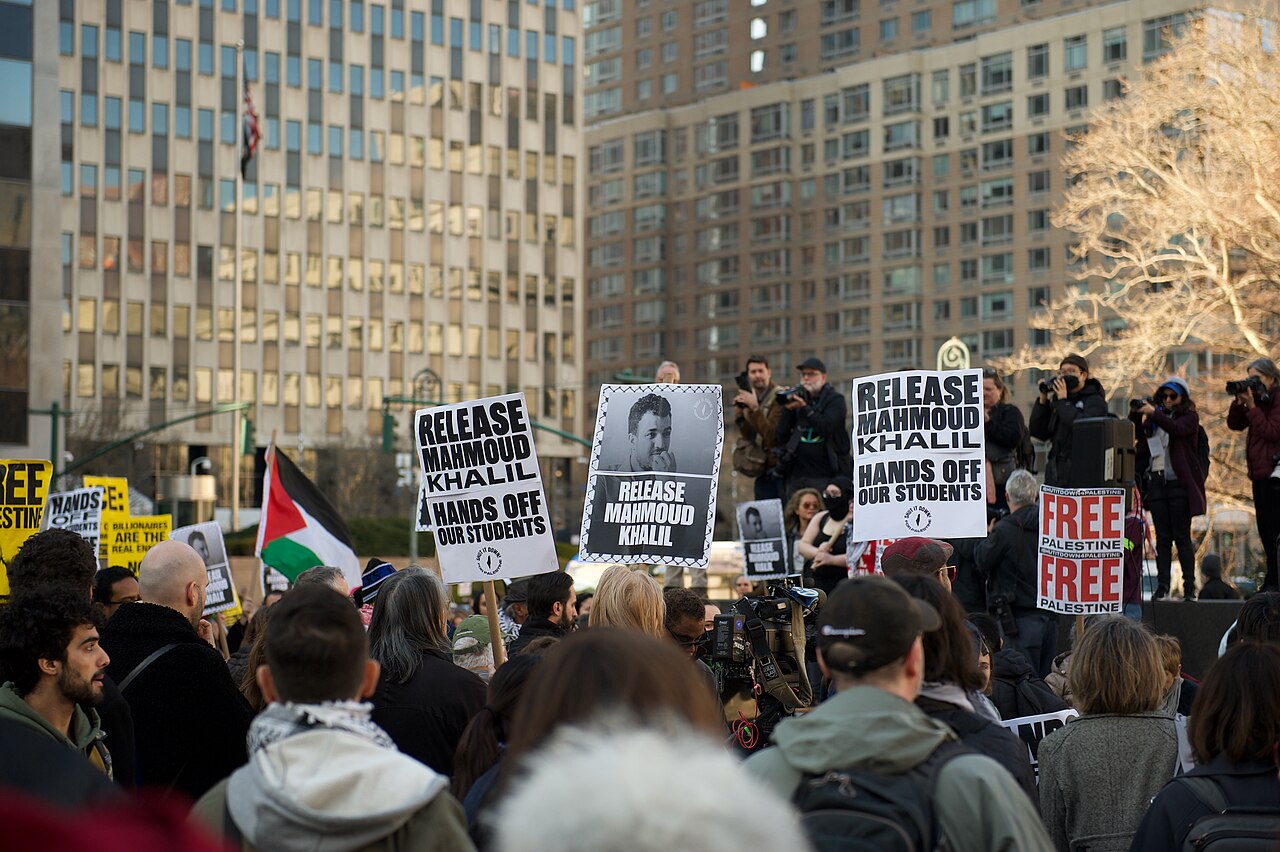Section 875 Is Having Its Moment
The Justice Department has found its new favorite statute to address domestic extremism.

Published by The Lawfare Institute
in Cooperation With

On Dec. 6, the Justice Department unveiled charges against an Arizona “extremist” preacher who prosecutors say had encouraged the murder of two police officers in Australia. The arrest led nearly every news outlet in that country but barely made a blip in U.S. news.
One of the key reasons? Arrests for communicating threats are becoming increasingly common in the United States. In the past month, the Department of Justice has charged 25 people with 18 U.S.C. § 875 (c), “communicating a threat.” The recent increased use of this charging vehicle is unprecedented in the American criminal justice system. To wit: a Utah man threatening a Palestine rights organization, a Florida man wishing death on a Jewish organization, a transgender woman threatening to copycat the Nashville Tennessee shooter, a Georgia man promising to kill Rep. Marjorie Taylor Greene (R-Ga.), a Florida woman threatening a Texas judge who is overseeing a reproductive rights case, a New Hampshire man saying he is going to kill everyone at a Republican presidential campaign event, an Arizona man dancing to “Let’s Go Brandon” with guns after threatening to murder FBI agents. The list goes on.
A review by the University of Nebraska at Omaha’s National Counterterrorism, Innovation, Technology, and Education Center and Chapman University found that there has been a steady increase in arrests of individuals threatening public officials over the past 10 years. In 2013, there were 38 federal cases. In 2022, the case total nearly doubled to 74, marking a record for the decade. This year, prosecutors have already set yet another new record with 76 cases filed so far with still a few more weeks left in the year. What’s more, the increase in ideologically motivated threat arrests accounts for the significant jump in recent years.
No doubt, threat prosecutions are used outside those with an ideological agenda. There are plenty of examples in recent weeks of prosecutors using the statute to address individuals upset at a recurring bank fee or an unhinged man using it as a frightening tactic to control his would-be Hinge dates. There are, however, also a number of factors to explain why 875 is getting the increased exercise in today’s political climate and against ideologically motivated individuals.
First, it’s one of the few statutes that can address the full range of domestic extremism ideologies from far right, far left, single issue, and everything in between. When it comes to countering domestic terrorism, the federal government lacks many of the same legal hooks that are present in international terrorism investigations. For example, if someone threatens to kill a U.S. senator on behalf of ISIS, there’s arguably an avenue to charge that person with material support to the Islamic State. However, if that same individual threatened that same elected official on behalf of a white supremacist ideology or ecoterrorism, there’s no designated group to “provide material support to.” In the past, terrorism prosecutors have relied on other charges, such as “possession of a firearm by an unlawful user of a controlled substance,” but recent court decisions have started to take that option off the table, finding that an individual’s Second Amendment rights make such charges invalid. As the nonterrorism charging options for terrorism suspects narrow, prosecutors are forced to lean on the threat statute.
Second, as the FBI says its number of open terrorism investigations continues to rise, 18 U.S.C. § 875 provides a way to close a case much faster than a traditional domestic terrorism operation. Over the past few months, we’ve interviewed law enforcement members and prosecutors around the country who strongly believe that today’s threat landscape is shifting. Almost uniformly, they talk about how the so-called “flash to bang” of rhetoric to violent action is getting shorter. It takes time and resources to build a more complex case against domestic extremists. For example, an introduction to the suspect of an FBI informant almost always requires a backstory, hours of covert meetings, and an articulated attack plot by the defendant. In turn, “communicating a threat” is still a complex investigation, often involving filing search warrants, sometimes trying to discourage the individual from continuing to advocate violence and the like, but it is by and large a less resource-intensive law enforcement endeavor. A terrorism investigation typically requires the FBI to provide opportunities for the suspect to change their mind or back out of the plot, allowing for a stronger argument against a future defense motion of entrapment. Threat cases simply need the one-time act of communicating a threat, with very little—or, in most cases, no—involvement of undercover agents or informants and shorter time frames for counterterrorism investigations. An example of this played out this month, when a New Hampshire man was arrested three days after threatening to kill a Republican presidential candidate. A typical domestic terrorism investigation, not relying on 875, takes weeks, months, and sometimes years to arrive at an arrest.
Third, there appears to be a convergence of multiple extremist ideologies that makes traditional terrorism federal charges nearly impossible to argue in front of a jury. Of the 18 U.S.C. § 875 cases this year, a number of them do not fit neatly into one single ideological bucket—for example, the Ohio national guardsman who promoted white supremacy and antisemitism while espousing “incel” ideology. In broader terms, that an individual can simultaneously hold multiple, even seemingly conflicting, belief systems—say, be an al-Qaeda supporter, an incel adherent, and quote “The Turner Diaries” with ease—is a level of nuance and complication that most juries simply won’t understand. Section 875 provides a relatively easier pathway that allows prosecutors to pursue conviction without having to navigate complicated processes of proving the defendant in question fits into a specific ideological category and that their actions were somehow connected to that ideological perspective. A threat charge can be presented in simpler terms to a jury. Under 875, prosecutors focus on a narrow area of concern: Did the individual communicate an actionable threat using a means of communication that crosses state lines (internet, phone, mail, and so on)? Yes. To convict them, does it matter what group or ideology they adhered to when doing so? No. Law enforcement wants to arrest individuals they’re concerned will commit violence. Prosecutors want to bring forth charges that have little chance of losing. An interstate commerce threat charge provides that avenue.
Fourth, like most federal charges, the Justice Department wins threat cases. In the past few years, the vast majority of 875 prosecutions ended with an individual pleading guilty before trial. And those who try their luck with a jury pool tend to lose. An uncontested criminal charge means less precedent for future defense attorneys to argue new and creative ways that threats made by defendants are protected speech and arguably creates more room for prosecutors to push the statute toward charging people who have articulated more generalized, less specific threat language that is concerning nonetheless.
Fifth, not to completely railroad the previous paragraphs, but it’s worth noting one other possibility to account for the steady rise in prosecutions. The increase in the number of threat cases could be something as simple as an increased interest by the Justice Department to take on threat cases, and not that there is an actual increase in threats. This argument, however, loses weight quickly when put in the context that the U.S. Capitol Police have seen threat investigations double in the past five years and three out of four election workers say threats against them are rising. And it’s not limited to poll workers and elected officials. Nearly a quarter of medical personnel reported harassment on social media. In a memo to the field, Attorney General Merrick Garland cited an “disturbing spike … in threats of violence against school administrators, board members and teachers.” Any increased focus by the Justice Department could explain some of the rise in prosecutions, but it is unlikely to account for all of it.
And finally—and this may lack the level of nuance that one should typically expect from academia, but it’s true, nevertheless—a lot of Americans seem very mad about a lot of things. A short amount of time on social media quickly gives one that sense, but the threat prosecutions provide a way to actually measure it. Unless everyone’s proverbial temperature lowers, observers can expect the Justice Department to continue to rely heavily on 18 U.S.C § 875 for the foreseeable future.





.jpg?sfvrsn=d5e57b75_7)
